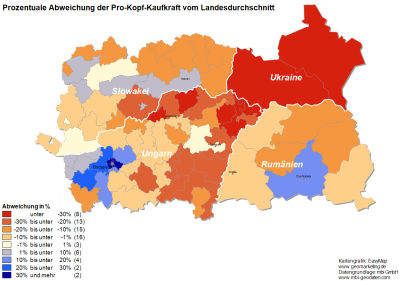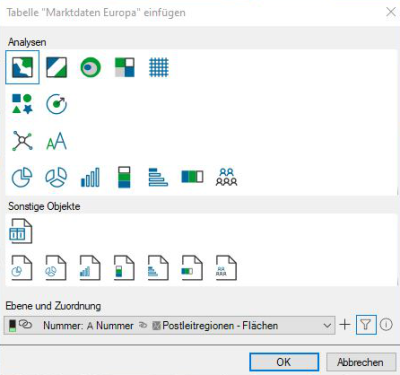Area Shading
With the command Area coloring easymap offers the possibility to color the areas of the regions in the map depending on a data column.
Creating a New Analysis
Inserting the area shading
First select in the control window data your table column on which the analysis should refer to. To insert an analysis, drag and drop the table column onto the map using drag and drop. A new dialog box opens. For the area coloring select the corresponding icon in the Analysis section.
Afterwards, set at level and assignment the appropriate level on which the staining should take place. easymap suggests the most suitable assignment of the already used assignments. If you have not set any assignment yet, easymap checks all possible assignments and suggests the assignment with the highest assignment result. In case of a area analysis, however, you only have the possibility to make an assignment via an area number, because you want to perform an analysis on area level.
To finish the analysis, confirm your selection with Ok.
You can adjust all settings later in the Properties window the Area shading.
Note: You can also insert your analysis via the menu bar Analyze. You get an analysis without predefined settings and value classes.
- What does the assignment result tell you?
- Would you like to place your data on the map using geographical coordinates? So the The Data Input for an Analysis.
- The Advanced button allows you to specify whether the analysis should consider an existing clip map when calculating classifications - more on the analysis reference.
Set the Properties of the Area Shading
If you have inserted the analysis by Drag&Drop, color classes are automatically created for you in relation to the data column used. If you have inserted your analysis via the main menu, all areas for which corresponding data sets are available in the data basis will be colored uniformly in the beginning.
You can then adjust and change all settings.
The color can be changed in the properties of the area coloring at will via the color selection field.
In the properties, you can also select or change the Data column that you want to evaluate from the Table of the database.
After selecting the data basis, you can determine the column you want to visualize in the properties from the previously selected table. Four display types are available: Uniform, Classified, Continuous and Default.
Classified Area shading
Classified area coloring offers you numerous setting options. In addition to the number of classes, you can specify how the limit values of the value classes are to be determined.
- First select the column to be evaluated.
- With a area-related analysis you can additionally determine aggregation of the data of the selected column. This specifies the rule how data are combined if several data are available for an area.
-
The Format option is only available for area-specific analyses. Normally, the formatting of the selected data column is also used for the analysis result; this is always the case for site-specific analyses. For certain aggregation procedures (for example, number of values), however, this formatting cannot be used meaningfully. You can define a new formatting here, which is used in legends for this analysis, for example.
- Under Statistics you can display statistical information (e.g. number of data records, min., max.) for the selected column - click on the button in the field next to Statistics.
- In the middle area, enter Classes, the Count for classes, and the method of automatic Classification or set here to User defined to edit your own classes. In addition to Analysis range, you can also specify an interval within which the values are to be taken into account. Values outside the interval always fall into the residual class "unclassified".
- In the lower section you can then determine the details of the analysis (class list). You can use various commands to edit the classes and colors.
- The design characteristics and class boundaries can be edited by double-clicking in the relevant cell. For example, you can select the color individually by double-clicking on the color of the class.
- for further information on editing classes, symbols, colors and sizes, see here.
Note: By sorting according to the name of the class, you can force a certain order in the legend!
Continuous area shading
The Continuous area shading offers you the convenience of a continuous color gradient without specifying classes. The continuous coloring of the areas is only available for number columns.
As with the classified option, you can limit the analysis area or define a color gradient, or define color outside of the analysis area.
Use the slider to the left of the gradient to change the gradient. This allows the color ranges to be enlarged or reduced over the entire data range.
Preset Area shading
The Default option is useful if the colors for the areas in a data table are available as RGB values (hexadecimal, e.g. #00FF00). The data column with the HTML color coding should be present in the selected table and selected here.
Determine the details of the analysis
In Details you define other (non-data-dependent) properties of the analysis.
| Visibility | |
| General |
Here you can control the visibility of objects and elements. |
| Scale range |
Here you can set whether the selected object or plane should be visible at each scale. Or you can specify the scale or zoom level at which the object or layer is visible. |
| In reports |
In Reports there is the possibility to change the environment only partially to zeigen. You can use this property to specify whether the layer is also visible outside the report area in this case. |
| Size adjustment |
Specify here how the size of a symbol or diagram behaves when the map scale is changed. This can change e.g. after zoom within the map, after setting a clip map or within a report, because only a part of the map is displayed. More about Size adjustment at auto zoom. |
| Alternating visibility group |
Set a group for mutual visibility here. If the element is to be made equally visible with other elements, you must use the same name for the visibility group. |
| Simultaneous visibility group |
Set a group for simultaneous visibility here. If the element is to be made mutually visible with other elements, you must use the same name for the visibility group. |
| Common | |
| Type of Shading | Here you can select whether the color of the areas full area or only as edge color should appear. With this option, loosened maps are possible, which allow not only the analysis of the surface coloration but also a further evaluation, without the map appearing overloaded and not really readable. |
| Width of the Colored Border |
Here you can set the width for the edge coloring in cm . |
| Comment | Enter here a comment for the display of the workbook in EasyMap Xplorer. The comment is also displayed in EasyMap as a tooltip in the control window Contents. |
Create tooltips for analysis
When crossing the colored areas on the map, you can display context-sensitive information about them.
Note: You can find out how to implement tooltips here.
The commands of the context menu
You can right-click on the analysis in the Contents control window to open its context menu. The context menu provides actions that can be performed on this analysis.
| Transfer Selection to |
Transfers the current selection geographically to another object. Details... |
| Visible |
Shows whether the object is visible and allows switching the visibility. |
| Order |
Here you can change the selected element in the character sequence. Another option is to drag and drop the selected element within the content view. |
| Input Data... |
Displays the data settings for the selected analysis. You can use this command later to change the connection between the analysis and the data. Further information can be found here. |
| Show Results Table | Displays the results of the selected analysis in a table. |
| Ignore filter |
Defines whether an Analysis filter should be considered or not. |
| Restore defaults |
Undoes all manual changes to this layer. |
| Clip Map |
Here you can define a different clip map for the analysis. |
| Map XY |
Here you will find various commands for the map. |
| Copy |
Copy the object (if necessary with all subobjects) to the clipboard to paste it elsewhere. The object can be inserted in other applications as a graphic, or inserted in EasyMap as a copy of this object using the Insert command. |
| Paste |
Pastes the contents of the clipboard into this object as a child object. |
| Delete | Deletes the selected element. (See also: delete objects) |
|
Rename |
Changes the content view to an edit mode to give the object a new name. (This can also be achieved by clicking on an object that has already been marked.) |
| Properties... |
Opens a properties dialog in which you can edit the Properties of the selected object. If several objects are selected, many properties can also be changed simultaneously for these objects. |




